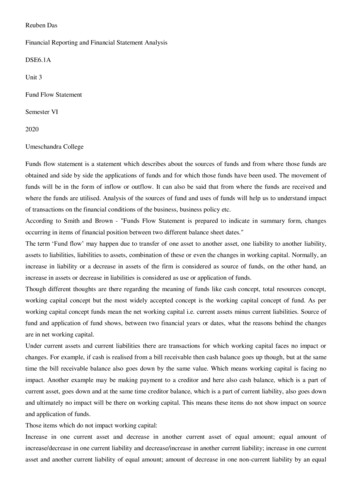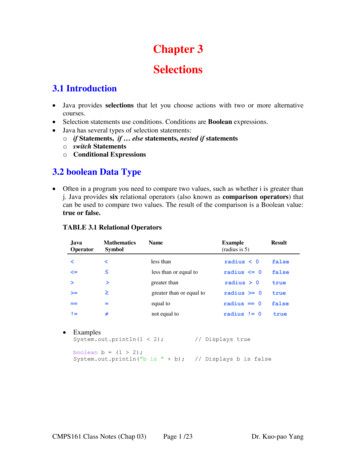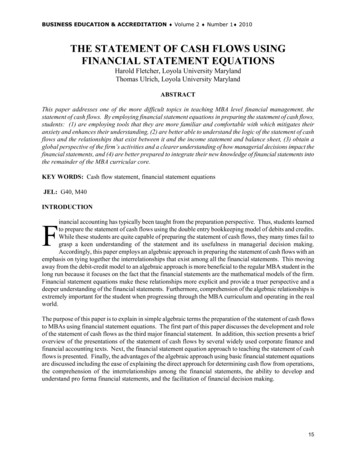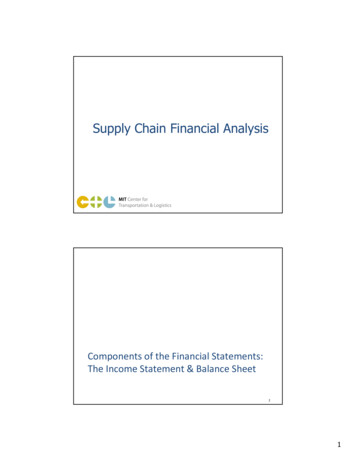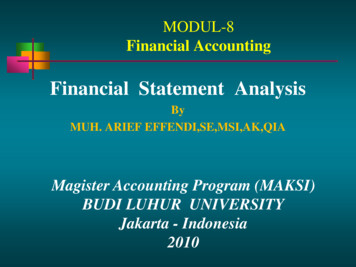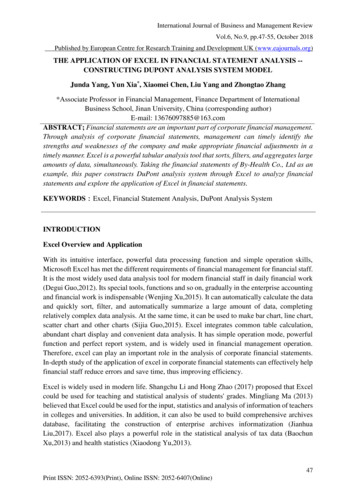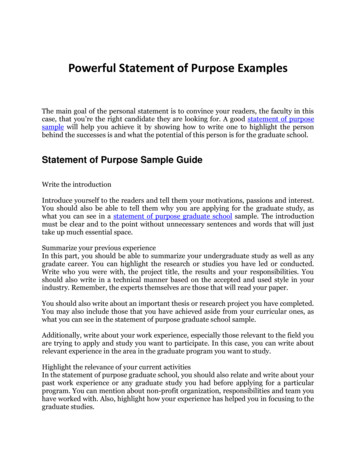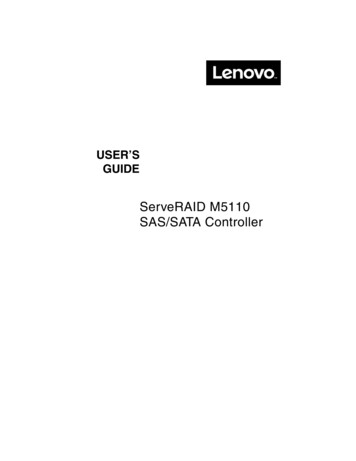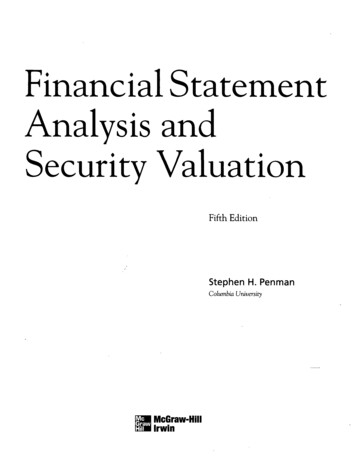
Transcription
Financial StatementAnalysis andSecurity ValuationFifth EditionStephen H. PenmanColumbia UniversityMcGraw-HillIrwin
ContentsList of Cases xxvList of Accounting Clinics xxviChapter 1Introduction to Investing and Valuation 2Investment Styles and Fundamental AnalysisBubble, Bubble, Toil, and Trouble 6How Bubbles Work 7Analysts During the Bubble 8More Toil and Trouble 8Fundamental Analysis Anchors Investors3Measurement in the Financial Statements9The Setting: Investors, Firms, Securities,and Capital Markets 10The Business of Analysis:The Professional Analyst 12Investing in Firms: The Outside Analyst 12Investing Within Firms: The Inside Analyst 13The Analysis of Business14Strategy and Valuation 15Mastering the Details 16The Key Question: Sustainabilityof Competitive Advantage 17Financial Statements: The Lens onthe Business 17Choosing a Valuation Technology18Guiding Principles 18Anchoring Value on the Financial Statements 20How to Use This Book21An Outline of the BookThe Income Statement 36The Cash Flow Statement 40The Statement of Shareholders 'Equity 40The Footnotes and SupplementaryInformation to Financial Statements 41The Articulation of the Financial Statements:How the Statements Tell a Story 42Summary 55The Web Connection 55Key Concepts 56The Analyst's Toolkit 57A Continuing Case: Kimberly-Clark Corporation 57Concept Questions 63Exercises 63Minicase 69PART ONEFINANCIAL STATEMENTSAND VALUATION 72Chapter 321The Web Connection 22Key.Concepts 22A Continuing Case: Kimberly-Clark Corporation 24Concept Questions 27Exercises 28Minicase 30How Financial StatementsAre Used in Valuation 74Chapter 2Asset-Based Valuation 82Fundamental Analysis 84Introduction to the Financial Statements 32The Analyst's Checklist 33The Form of the Financial StatementsIntroducing Nike, Inc. 34The Balance Sheet 34xviii44The Price-to-Book Ratio 44Measurement in the Balance Sheet 46Measurement in the Income Statement 46The Price-Earnings Ratio 50Accounting as an Anchor: Don't MixWhat You Know with Speculation 51Tension in Accounting 53Accounting Quality 5434The Analyst's ChecklistMultiple Analysis 7675The Method of Comparables 76Screening on Multiples 79The Process of Fundamental Analysis 85Financial Statement Analysis, Pro FormaAnalysis, and Fundamental Analysis 86The Architecture of Fundamental Analysis:The Valuation Model 87
ContentsTerminal Investments and Going-ConcernInvestments 88Valuation Models for Terminal Investments 89Valuation Models for Going-ConcernInvestments 91Criteria for a Practical Valuation Model 91What Generates Value? 92Valuation Models, the Required Return,and Asset Pricing Models 96Summary 97The Web Connection 97Key Concepts 98The Analyst's Toolkit 99A Continuing Case: Kimberly-Clark Corporation 99Concept Questions 100Exercises 101Minicases 104Appendix The Required Return andAsset Pricing Models 106Chapter 4Cash Accounting, Accrual Accounting,and Discounted Cash Flow Valuation 110The Analyst's Checklist 111The Dividend Discount Model 111The Discounted Cash Flow Model 114Free Cash Flow and Value AddedThe Statement of Cash Flows117119The Cash Flow Statement under IFRSForecasting Free Cash Flows 123122Cash Flow, Earnings, and Accrual Accounting124Earnings and Cash Flows 124Accruals, Investments, and theBalance Sheet 127Summary 129The Web Connection 129Key Concepts 130The Analyst's Toolkit 130A Continuing Case: Kimberly-Clark Corporation 131Concept Questions 131Exercises 132Minicase 138Chapter 5142Valuing a Project 142Valuing a Savings Account 143The Normal Price-to-Book Ratio 144A Model for Anchoring Value on Book Value145Residual Earnings Driversand Value Creation 147A Simple Demonstration and aSimple Valuation Model 150Applying the Model to Equities151The Forecast Horizon and theContinuing Value Calculation 152Beware of Paying Too Much for Growth 155Converting Analysts' Forecaststo a Valuation 156Build Your Own Valuation Engine 157Applying the Model to Projects and Strategies 159Features of the Residual Earnings Valuation 161Book Value Captures Value and ResidualEarnings Captures Value Added toBook Value 161Protection from Paying Too Much forEarnings Generated by Investment 162Protection from Paying Too Muchfor Earnings Created by the Accounting 163Capturing Value Not on the BalanceSheet—for All Accounting Methods 164Residual Earnings Are Not Affected byDividends, Share Issues, or ShareRepurchases 165What the Residual Earnings Model Misses 165The Web Connection 165Summary 165Key Concepts 166The Analyst's Toolkit 166A Continuing Case: Kimberly-Clark CorporationConcept Questions 167Exercises 168Minicases 173141Beware of Paying Too Much for Earnings141167Chapter 6Accrual Accounting and Valuation:Pricing Earnings 178The Analyst's Checklist179The Concept Behind the Price-Earnings RatioAccrual Accounting and Valuation:Pricing Book Values 140The Analyst's Checklist 141The Concept Behind the Price-to-Book RatioPrototype ValuationsxixBeware of Paying Too Much for EarningsGrowth 180From Price-to-Book Valuation toP/E Valuation 180179
XXContentsPrototype Valuation181A Continuing Case: Kimberly-Clark Corporation 223Concept Questions 224Exercises 225Minicases 229The Normal Forward P/E Ratio 183The Normal Trailing P/E Ratio 184A Poor P/E Model 185A Model for Anchoring Value on Earnings185Measuring Abnormal Earnings Growth 187A Simple Demonstration and a SimpleValuation Model 188Anchoring Valuation on Current Earnings 189Applying the Model to Equities190Converting Analysts 'Forecaststo a Valuation 191Chapter 8Viewing the Business Throughthe Financial Statements 234Build Your Own Valuation Engine 192Features of the Abnormal EarningsGrowth Model 194Buy Earnings 195Abnormal Earnings Growth Valuationand Residual Earnings Valuation 195Abnormal Earnings GrowthIs Not Affected by Dividends,Share Issues, or Share Repurchases 196Accounting Methods and Valuation 196The Fed Model 197PEG Ratios 199Summary 200The Web Connection 201Key Concepts 201The Analyst's Toolkit 201A Continuing Case: Kimberly-Clark Corporation 202Concept Questions 202Exercises 203Minicase 208Chapter 7Valuation and Active Investing 210The Analyst's Checklist 211' How .the Fundamental Investor Operates/211Common Misconceptions About Valuation 211Applying Fundamental Principles 213Challenging Speculation in the Market PriceReverse Engineering the S&P 500 215Challenging the Price of a Stock 218Reverse Engineering with the AbnormalEarnings Growth Model 221Build Your Own Active Investing ToolThe Web Connection 222Summary 222Key Concepts 223The Analyst's Toolkit 223PART TWOTHE ANALYSIS OF FINANCIALSTATEMENTS 232222213The Analyst's Checklist 23 5Business Activities: The Cash Flows236The Reformulated Cash Flow StatementThe Reformulated Balance Sheet 241Business Activities: All Stocks and FlowsThe Reformulated Income Statement240242243Accounting Relations That GovernReformulated Statements 243The Sources of Free Cash Flow and theDisposition of Free Cash Flow 244The Drivers of Dividends 244The Drivers of Net Operating Assetsand Net Indebtedness 245Tying It Together for Shareholders:What Generates Value? 246Build Your Own Analysis Engine 248Summary 250The Web Connection 250Key Concepts 251The Analyst's Toolkit 251A Continuing Case: Kimberly-Clark Corporation 252Concept Questions 252 ,Exercises 253Chapter 9The Analysis of the Statementof Shareholders'Equity 258 The Analyst's Checklist 259Reformulating the Statement of Owners' EquityRunning with Nike 260Reformulation ProceduresDirty-Surplus Accounting260263Comprehensive Income ReportingUnder U.S. GAAP andIFRS 265259
ContentsRatio Analysis266Chapter 11Payout and Retention Ratios 266Shareholder Profitability 267Growth Ratios 267Hidden Dirty SurplusxxiThe Analysis of the Cash Flow Statement 342268Issue of Shares in Operations 268Issue of Shares in Financing Activities 272Handling Diluted Earnings per Share 2 72Share Transactions in Inefficient Markets 274The Eye of the Shareholder 275Build Your Own Analysis Engine 276Accounting Quality Watch 276The Web Connection 278Summary 278Key Concepts 278The Analyst's Toolkit 279A Continuing Case: Kimberly-Clark Corporation 280Concept Questions 281Exercises 282Minicase 288The Analyst's Checklist 343The Calculation of Free Cash Flow 343GAAP Statement of Cash Flows andReformulated Cash Flow Statements345Reclassifying Cash Transactions 346Tying It Together 351Cash Flow from Operations 353Summary 355The Web Connection 355Key Concepts 356The Analyst's Toolkit 356A Continuing Case: Kimberly-Clark Corporation 356Concept Questions 357Exercises 357Minicase 362Chapter 12The Analysis of Profitability 364The Analyst's Checklist 365The Analysis of Return on Common Equity 365First-Level Breakdown: Distinguishing Financingand Operating Activities and the Effectof Leverage 366Chapter 10The Analysis of the BalanceSheet and Income Statement292The Analyst's Checklist 293Reformulation of the Balance Sheet293Issues in Reformulating Balance SheetsStrategic Balance Sheets 301Reformulation of the Income Statement294303Tax Allocation 304Issues in Reformulating IncomeStatements 308Value Added to Strategic Balance SheetsResidual Income from Operations 312312Comparative Analysis of the Balance Sheetand Income Statement 314Common-Size AnalysisTrend Analysis 316315Ratio Analysis 318Build Your Own Analysis Engine 321Summary 321The Web Connection 322Key Concepts 322The Analyst's Toolkit 323A Continuing Case: Kimberly-Clark Corporation 324Concept Questions 325Exercises 325Minicases 334Financial Leverage 366Operating Liability Leverage 368Summing Financial Leverage andOperating Liability Leverage Effects onShareholder Profitability 370Return on Net Operating Assets andReturn on Assets 3 71Financial Leverage andDebt-to-Equity Ratios 373Second-Level Breakdown: Driversof Operating Profitability 373Third-Level Breakdown 376Profit Margin Drivers 3 76Turnover Drivers 3 76Key Drivers 379Borrowing Cost Drivers 380Build You Own Analysis Engine 381The Web Connection 382Summary 382Key Concepts 382The Analyst's Toolkit 383A Continuing Case: Kimberly-Clark Corporation 383Concept Questions 384
xxii ContentsExercises 385Minicase 391A Modification to Residual Earnings Forecasting:Residual Operating Income 438Chapter 13The Analysis of Growth andSustainable Earnings 392A Modification to Abnormal EarningsGrowth Forecasting: Abnormal Growthin Operating Income 443The Drivers of Residual Operating IncomeThe Analyst's ChecklistWhat Is Growth? 393Abnormal Growth in Operating Income andthe "Dividend" from Operating Activities 443Eye on the Future: Sustainable Income 445393The Cost of Capital and ValuationWarnings About Growth 394Cutting to the Core: Sustainable Earnings396Core Operating Income 396Issues in Identifying Core Operating Income 397Core Operating Profitability 404Core Borrowing Cost 406Analysis of Growth407Growth Through Profitability 407Operating Leverage 408Analysis of Changes in Financing 409Analysis of Growth in Shareholders' Equity 409Growth, Sustainable Earnings, and the Evaluationof P/B Ratios and P/E Ratios 411How Price-to-Book Ratios andTrailing P/E Ratios Articulate 411Trailing Price-Earnings Ratiosand Transitory Earnings 414P/E Ratios and the Analysis ofSustainable Earnings 416Price-to-Book and Growth 416Summary 417The Web Connection 417Key Concepts 418The Analyst's Toolkit 419A Continuing Case: Kimberly-Clark Corporation 419Concept Questions 420Exercises 421Minicases 425PART THREEFORECASTING AND VALUATIONANALYSIS 434Chapter 14The Value of Operations and theEvaluation of Enterprise Price-to-BookRatios and Price-Earnings Ratios 436The Analyst's Checklist437441445The Cost of Capital for Operations 446The Cost of Capital for Debt 44 7Operating Risk, Financing Risk, and theCost of Equity Capital 448Financing Risk and Return and theValuation of Equity 450Leverage and Residual Earnings Valuation 450Leverage and Abnormal Earnings GrowthValuation 451Leverage Creates Earnings Growth 456Debt and Taxes 459Mark-to-Market Accounting: A Tool forIncorporating the Liability for StockOptions in Valuation 461Enterprise Multiples 463Enterprise Price-to-Book Ratios 463Enterprise Price-Earnings Ratios 465Summary 468The Web Connection 468Key Concepts 469The Analyst's Toolkit 469A Continuing Case: Kimberly-Clark Corporation 470Concept Questions 471Exercises 472Minicase 477Chapter 15Anchoring on the Financial Statements:Simple Forecasting and SimpleValuation 480The Analyst's Checklist 481Simple Forecasts and Simple Valuations482Introducing PPE, Inc. 482The No-Growth Forecast and Valuation 483The Growth Forecast and Valuation 484Simple Forecasting: Adding information toFinancial Statement Information 488Weighed-Average Forecasts of Growth 488
ContentsSimple Valuations with Short-Termand Long-Term Growth Rates 488Growth in Sales as a Simple Forecastof Growth 489Information in Analysts'Forecasts 490Simple Valuation as an Analysis ToolPART FOURACCOUNTING ANALYSISAND VALUATION 552Chapter 17491Creating Accounting Value andEconomic Value 554Sensitivity Analysis 491Reverse Engineering to Challengethe Market Price 491Summary 492The Web Connection 493Key Concepts 493The Analyst's Toolkit 493A Continuing Case: Kimberly-Clark Corporation 494Concept Questions 494Exercises 494Minicases 500Chapter 16Full-Information Forecasting, Valuation,and Business Strategy Analysis 504The Analyst's Checklist 505Financial Statement Analysis: Focusing the Lenson the Business 5051. Focus on Residual Operating Incomeand Its Drivers 5062. Focus on Change 5073. Focus on Key Drivers 514 .4. Focus on Choices Versus Conditions 515Full-Information Forecasting andPro Forma Analysis 515Mergers and Acquisitions 527Share Repurchases and BuyoutsThe Analyst's Checklist 555Value Creation and the Creationof Residual Earnings 555Accounting Methods, Price-to-Book Ratios,Price-Earnings Ratios, and the Valuationof Going Concerns 558Accounting Methods with a ConstantLevel of Investment 558Accounting Methods with a ChangingLevel of Investment 561An Exception: LIFO Accounting 565Hidden Reserves and the Creation of EarningsConservative and Liberal Accountingin Practice 570LIFO Versus FIFO 571Research and Development in thePharmaceuticals Industry 572Expensing Goodwill and Research andDevelopment Expenditures 573Liberal Accounting: Breweries and HotelsProfitability in the 1990s 574Economic- Value-Added Measures 5 75Accounting Methods and the Forecast HorizonA Forecasting Template 520Features of Accounting-Based Valuation 525Value Generated in Share Transactions526528Financial Statement Indicators and Red FlagsBusiness Strategy Analysis and Pro FormaAnalysis 530xxiii528Unarticulated Strategy 530Scenario Analysis 531The Web Connection 532Summary 532Key Concepts 533The Analyst's Toolkit 533A Continuing Case: Kimberly-Clark Corporation 534Concept Questions 534Exercises 535Minicases 542566574575The Quality of Cash Accounting andDiscounted Cash Flow Analysis 576Growth, Risk, and Valuation 577Summary 578The Web Connection 579Key Concepts 579The Analyst's Toolkit 5 80Concept Questions 580Exercises 581Minicase 586Chapter 18Analysis of the Qualityof Financial Statements 590The Analyst's Checklist 591What Is Accounting Quality? 591Accounting Quality Watch 592Five Questions About Accounting Quality593
xxivContentsCutting Through the Accounting:Detecting Income Shifting 594Separating What We Know fromSpeculation 597Prelude to a Quality Analysis 598Quality Diagnostics 600Diagnostics to Detect Manipulated Sales 603Diagnostics to Detect Manipulationof Core Expenses 604Diagnostics to Detect Manipulationof Unusual Items 612Detecting Transaction Manipulation 614Core Revenue Timing 614Core Revenue Structuring 614Core Expense Timing 615Releasing Hidden Reserves 615Other Core Income Timing 616Unusual Income Timing 616Organizational Manipulation: Off-BalanceSheet Operations 616Justifiable Manipulation? 617Disclosure Quality 617Quality Scoring 618Abnormal Returns to Quality Analysis 620Summary 621The Web Connection 621Key Concepts 621The Analyst's Toolkit 622Concept Questions 623Exercises 624Minicases 633PART FIVETHE ANALYSIS OF RISKAND RETURN 640Chapter 19TheXnalysis of Equity Riskand Return for Active Investing642The Analyst's Checklist 643The Required Return and the Expected Return 643The Nature of Risk 644The Distribution of Returns 644Diversification and Risk 648Asset Pricing Models 649Fundamental Risk 651Risk to the Return on Common Equity 653Growth Risk 654Value-at-Risk Profiling654Adaptation Options and Growth Options 659Strategy and Risk 660Discounting for Risk 660Price Risk 661Market Inefficiency Risk 661Liquidity Risk 664Inferring Expected Returns for Active Investing 664Growth-Return Profiles 666Finessing the Required Return Problem 667Evaluating Implied Expected Returns withValue-at-Risk Profiles 667Investing Within Risk Classes 668Beware of Paying for Risky Growth 668Expected Returns in Uncertain Times 670Summary 670The Web Connection 671Key Concepts 671The Analyst's Toolkit 672Concept Questions 672Exercises 672Minicase 678Chapter 20The Analysis of Credit Risk and Return 680The Analyst's Checklist 681The Suppliers of Credit 681Financial Statement Analysis for Credit Evaluation 682Reformulated Financial Statements 682Short-Term Liquidity Ratios 684Long-Term Solvency Ratios 686Operating Ratios 687Forecasting and Credit Analysis 687Prelude to Forecasting: The InterpretiveBackground 687Ratio Analysis and Credit-Scoring 688Full-Information Forecasting 692Required Return, Expected Return, and ActiveDebt Investing 695Active Bond Investing 696Liquidity Planning and Financial Strategy 696The Web Connection 697Summary 697—Key Concepts 698The Analyst's Toolkit 698Concept Questions 699Exercises 699Minicase 704AppendixA Summary of Formulas 709Index 725
How Financial Statements Are Used in Valuation 74 The Analyst's Checklist 75 Multiple Analysis 76 The Method of Comparables 76 Screening on Multiples 79 Asset-Based Valuation 82 Fundamental Analysis 84 The Process of Fundamental Analysis 85 Financial Statement Analysis, Pro Forma Analysis, and Fundamental Analysis 86 The Architecture of .
